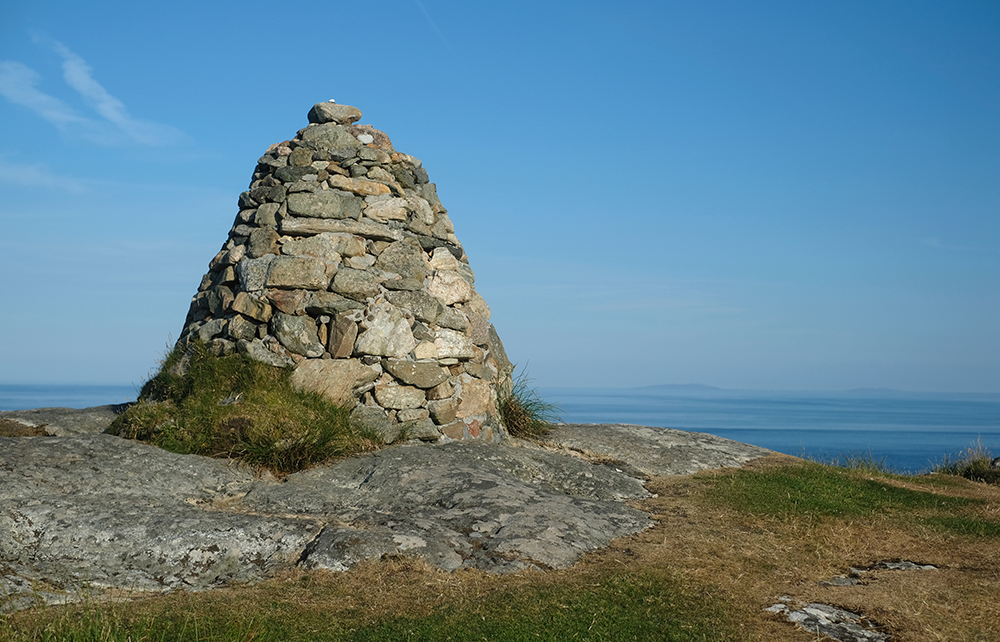‘Let me leave Cairn here as a trail marker, a moment noted, a view from the strange here-and-now,’ Kathleen Jamie states towards the end of the prologue to her exquisite new collection of writings. In more than 40 micro-essays and poems, her keen-eyed view encompasses both an uninhabited island far out at sea and a piece of flint in her hand; it accommodates surfacing memories and also peers into the uncertain future awaiting the next generation.
A balanced tower of ultra-short pieces is a new form for Jamie, the Scottish makar (or national poet), who also pens longer pieces of nature writing, collected into the genre-expanding works: Findings, Sightlines and Surfacing. If, in Cairn, the brevity of the prose is new, the signature traits of her writing persist: exploring human points of connection with the natural world, noticing beauty in the scientific and remaining attuned to the hidden subtleties of language – ‘Corvid, covid… what a difference a letter makes,’ she wryly observes. Interspersed with the luminous writings are delicate pencil drawings by Miek Zwamborn, their dots and shadings loosely forming natural phenomena observed in the book: birds, stones, the sea.
At ‘nearly 60’, Jamie is mindful of the insignificance of human time compared to the ‘deep time’ of stones
In ‘Moor’, Jamie notes: ‘We bring the past out of the land and bear the land into the future.’ This ‘past’ stretches to accommodate both personal memories and deeper time. In ‘The Handover’, one of the longest pieces, at eight pages, Jamie accompanies ‘youngsters’ on a climate change march and shares her memories of ‘women tying wool and baby toys on to the chain- link fence’ at Greenham Common. She notes the echo of both protest and cause: along with ‘young people’s fears’ of climate change, the new nuclear threat means ‘now they’ve got their parents’ nightmares to contend with too’. At ‘nearly 60’, when ‘the shape of my life’s arc is becoming visible’, Jamie is mindful of the insignificance of human time compared to the ‘deep time’ of stones. A quartz pebble is ‘volcano spit’, a flint core holds the story of its prehistoric owner ‘striking off slivers… ready to scrape a deer’s fat from its hide’. As John Berger posits in the book’s epigraph: ‘Stones propose another sense of time, whereby the past, the deep past of the planet, proffers a meagre yet massive support to acts of human resistance.’
We are in need of this ‘meagre yet massive support’ in Cairn, where the relationship between humans and the natural world is uneasy. Jamie gives space to protestors and protectors of nature, but is clear-sighted about human damage to the planet. In ‘Plasthvalen’, she writes movingly about her trip to the Whale Hall, or Hvalsalen, in Bergen. Displayed beside a whale skeleton are glass cylinders containing more than 30 plastic bags ‘that glint and shine’, found clogging the animal’s stomach and causing it to starve; it was ‘deceived’ into eating them because in its echolocation the bags resembled squid.
Jamie asserts the impossibility of finding reassurance in today’s natural world, but still heralds it as a place of wonder. In ‘The Midwinter Whale’, she gathers with other passers-by to watch a whale near the coast:
Yes, the blow. Two or three in quick succession hang like white shrubs above the water, dispersing as the animal’s long dark back appears to slide along the surface, a fleck of landscape on the sea.
She sets the whale’s magnificent ability to create, momentarily, a new land – complete with ‘white shrubs’ – in sharp contrast to the onlookers’ mundane ‘gossip’ about Covid and Christmas plans. In ‘The Bass Rock’, she documents the ravages of bird flu, watching ‘the seabird people, among their beloved birds… wearing hazmat suits as they pile corpses into bin bags’, and then looks up to see ‘a pennant of 20-odd gannets… passing, flying strongly, now rising, now falling’. There is space for both grief and wonder. She urges: ‘Stay alive!’
With trouble on the horizon, both geographical and temporal, Cairn inspires an appreciative scrutiny of ‘the here-and-now’. In ‘Hawkbit’, Jamie describes the flowers: ‘They open yellow into the moment – they are the moment – calling us to notice we are “snatched from death”, as the papers say, every fresh instant of our lives.’







Comments